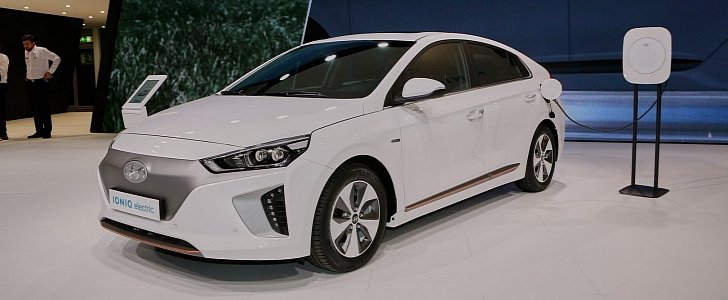Three different powertrains, one Korean car brand with huge ambitions in the green car market. There's no question that the Hyundai Ioniq looks interesting, but if you are considering buying one, which powertrain should you chose? Hopefully, seeing all of them together in Geneva will solve the riddle.
European pricing won't be available for all three models until the last quarter of 2016. But we have specs on all cars.
The first to be revealed before Geneva was the conventional hybrid. It shares all its body parts with the plug-in, except for the charging port mounted on the left side of the latter. The hybrid model is powered by a 1.6-liter GDI petrol engine producing 105 horsepower and tuned to run on the efficient Atkinson cycle. It gets a bit of help from a 32 kW electric motor that increases the total output to 141 hp.
Hyundai says that buyers of their Prius alternative can expect to get 79 grams per kilometer out of the tailpipe. However, because the battery only holds 1.56 kWh, running on electricity won't happen all that much.
As for the Ioniq Plug-In, this features the same powertrain and a much larger 8.9 kWh lithium-ion polymer battery. Thanks to it, the car will be able to run for up to 31 miles (50 km) on electricity alone. CO2 emissions will be as low as 32 grams per km, so it might be the one to get.
Finally, we have the Ioniq Electric, which is the most distinctive of the group. It features a silver plastic insert in place of the front grille, as well as a different rear bumper insert.
There's no gasoline engine on board this one, but the battery is much larger, capable of holding 28 kWh of electric juice, enough for a 165km/h (103mph) journey. The electric motor is said to deliver 120 hp and 295 Nm of torque through a single-speed reduction gearbox. We don't know how fast it will get to 100 km/h, but the top speed is rated at 165km/h (103mph).
The interiors of all models are pretty upmarket, featuring wireless phone charging, a 7-inch TFT instrument cluster, Apple CarPlay, Android Auto, and Tom Tom navigation. We like that Hyundai didn't go berserk with the styling and instead offered a logical setup with buttons and knobs were you expect them to be.
The first to be revealed before Geneva was the conventional hybrid. It shares all its body parts with the plug-in, except for the charging port mounted on the left side of the latter. The hybrid model is powered by a 1.6-liter GDI petrol engine producing 105 horsepower and tuned to run on the efficient Atkinson cycle. It gets a bit of help from a 32 kW electric motor that increases the total output to 141 hp.
Hyundai says that buyers of their Prius alternative can expect to get 79 grams per kilometer out of the tailpipe. However, because the battery only holds 1.56 kWh, running on electricity won't happen all that much.
As for the Ioniq Plug-In, this features the same powertrain and a much larger 8.9 kWh lithium-ion polymer battery. Thanks to it, the car will be able to run for up to 31 miles (50 km) on electricity alone. CO2 emissions will be as low as 32 grams per km, so it might be the one to get.
Finally, we have the Ioniq Electric, which is the most distinctive of the group. It features a silver plastic insert in place of the front grille, as well as a different rear bumper insert.
There's no gasoline engine on board this one, but the battery is much larger, capable of holding 28 kWh of electric juice, enough for a 165km/h (103mph) journey. The electric motor is said to deliver 120 hp and 295 Nm of torque through a single-speed reduction gearbox. We don't know how fast it will get to 100 km/h, but the top speed is rated at 165km/h (103mph).
The interiors of all models are pretty upmarket, featuring wireless phone charging, a 7-inch TFT instrument cluster, Apple CarPlay, Android Auto, and Tom Tom navigation. We like that Hyundai didn't go berserk with the styling and instead offered a logical setup with buttons and knobs were you expect them to be.























